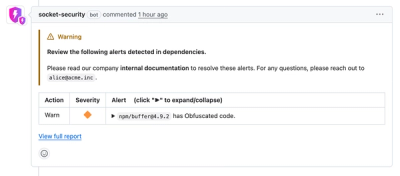
Security News
pnpm 10.16 Adds New Setting for Delayed Dependency Updates
pnpm's new minimumReleaseAge setting delays package updates to prevent supply chain attacks, with other tools like Taze and NCU following suit.
Versión en español en README.es.md <README.es.md>__
This application allows you use
Django <https://www.djangoproject.com/>__ model translations easily.
Everything is based on FieldTranslation, a class that stores the
translation of each field of your application models.
All the process is transparent and the entries are created when save is called.
You will not have to modify FieldTranslation, but you can read the code.
All code in in the github repository: https://github.com/intelligenia/modeltranslation
Installation
This application depends on
`django-cuser <https://pypi.python.org/pypi/django-cuser>`__ and
`TinyMCE <https://pypi.python.org/pypi/django-tinymce>`__, so you will
need to install it and put it in the list of INSTALLED\_APPS before
modeltranslation.
You are encouraged to use pip to install django-cuser.
The easiest way to install modeltranslation is by installing it from
`pipy <https://pypi.python.org/pypi/modeltranslation>`__:
.. code:: sh
pip install modeltranslation
Once you've done this, you can install modeltranslation in settings.py:
INSTALLED\_APPS = ( "tinymce", "cuser", "modeltranslation" )
Add IS\_MONOLINGUAL to settings.py
----------------------------------
You'll have to include a new setting in settings.py
IS\_MONOLINGUAL=False. IS\_MONOLINGUAL acts as a switch for
modeltranslation:
.. code:: python
# modeltranslation only works when IS_MONOLINGUAL is False
IS_MONOLINGUAL=False
Add TRANSLATABLE\_MODEL\_MODULES to settings.py
Add file setting TRANSLATABLE_MODEL_MODULES to settings.py. TRANSLATABLE_MODEL_MODULES contains a list of module paths that will be translated. For example:
.. code:: python
TRANSLATABLE_MODEL_MODULES = ["app1.models", "app2.models", "fees.models", "menus.models", ...]
Import addtranslations if each of your models.py files:
.. code:: python
from modeltranslation.translation import addtranslations
After that, you'll have to call addtranslations at the end of this file:
.. code:: python
addtranslations(__name__)
This call adds an observer that saves translations when save model method is executed.
Modify your models including a meta field "translatable_fields". This field is a list with the fields you want to translate.
For example:
.. code:: python
from django.db import models
class Event(models.Model):
name = models.CharField(blank=False, max_length=150, verbose_name=u"Name", help_text=u"Name of the event.")
description = models.TextField(blank=False, verbose_name=u"Description", help_text=u"Long description of the event.")
short_description = models.CharField(blank=False, max_length=150, verbose_name=u"Short description", help_text=u"Short description of the event.")
#...
## Event Meta
class Meta:
verbose_name = "event"
verbose_name_plural = "events"
translatable_fields = ("name", "description", "short_description")
And that's all!
Now you have everything configurated and can use modeltranslation
translations.
How to use translations in ModelForms
-------------------------------------
Make your ModelForm object inherits of TranslatableModelForm. This will
include automatically the extra fields for each language you have in
your website.
.. code:: python
from modeltranslation.forms import TranslatableModelForm
class EventForm(TranslatableModelForm):
pass
If you need to modify any of the fields in **init** method (for example
by changing the widget of one field), you'll have to call
\_add\_translation\_form\_fields after your changes.
For example:
.. code:: python
# EventForm __init__
def __init__(self, event, *args, **kwargs):
super(EventForm, self).__init__(*args, **kwargs)
# Adds TinyMCE editor but we also want this editor in other
# languages' description fields
self.fields["description"].widget = TinyMCE()
# Manually adition of translation fields
self._add_translation_form_fields()
Dynamic translations in Django templates
----------------------------------------
1. Include modeltranslation filters in each template you wan to use this
special filters.
.. code:: django
{% load modeltranslation_tags %}
2. Use filter "\_" with the object and one of its fields. This filter
will return the translation of that field in the current language.
For example:
.. code:: django
{{ event|_:"name" }} {# Translates event name #}
{{ event.area|_:"name" }} {# Translates area name #}
Dynamic translations in code
----------------------------
This application injects a new method to each translatable model:
**get\_trans\_attr**. This method returns the translation of the
attribute in the current language (if it exists), otherwise returns the
default value for this attribute:
For example:
.. code:: python
# Original event name
original_event_name event.name
# Translated event name
translated_event_name event.get_trans_attr("name")
Contact and suggestions
-----------------------
- Create a new issue in this repository.
- Email me at diegoREMOVE\_THIS@intelligeniaREMOVE\_THIS.com
FAQs
Modeltranslation is an utility to translate Django model fields.
We found that modeltranslation demonstrated a healthy version release cadence and project activity because the last version was released less than a year ago. It has 2 open source maintainers collaborating on the project.
Did you know?

Socket for GitHub automatically highlights issues in each pull request and monitors the health of all your open source dependencies. Discover the contents of your packages and block harmful activity before you install or update your dependencies.

Security News
pnpm's new minimumReleaseAge setting delays package updates to prevent supply chain attacks, with other tools like Taze and NCU following suit.

Security News
The Rust Security Response WG is warning of phishing emails from rustfoundation.dev targeting crates.io users.

Product
Socket now lets you customize pull request alert headers, helping security teams share clear guidance right in PRs to speed reviews and reduce back-and-forth.